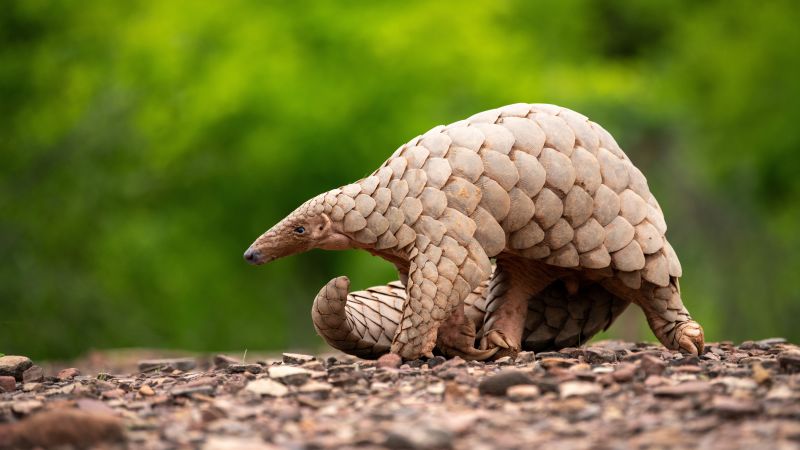
EDITOR’S NOTE: Call to Earth is a CNN editorial series committed to reporting on the environmental challenges facing our planet, together with the solutions. Rolex’s Perpetual Planet Initiative has partnered with CNN to drive awareness and education around key sustainability issues and to inspire positive action.
With hard, armorlike scales all over its body and tail; five-toed, sharply clawed feet; and a worm-like tongue that can extend up to 25 cm (10 inches), the pangolin looks more like a dinosaur than a mammal.
“They kind of remind you of the past because of the way they walk on their back legs, and they carry their little front legs up. It’s almost like a little T-Rex walking along,” says wildlife photographer and safari guide Tristan Dicks, who’s based in South Africa. “You feel like there’s this link to a time gone by.”
Pangolins have been around for 80 million years — humans just 350,000. But their future is uncertain. Found across Asia and Africa, all eight of the existing pangolin species are listed as threatened to various degrees by the International Union for the Conservation of Nature (IUCN).
Dicks’ photo of a Temmink’s pangolin is featured on the cover of “10 years of Remembering Wildlife,” the latest in a series of photo books from the Remembering Wildlife project, which donates its profits to conservation efforts.
Established in 2015 by photographer Margot Raggett, the initiative has produced a photo book dedicated to one type of endangered animal each year, raising over $1.55 million since it began, according to Remembering Wildlife. In this year’s edition, the pangolin takes center stage.
Pangolins are the world’s most illegally trafficked mammal, with poaching driven by demand for their meat and keratin scales, which are used predominantly in scientifically unproven traditional medicine.
Dr. Wendy Panaino, an ecologist who wrote a section dedicated to pangolins in the book, explains that “what makes them particularly vulnerable to poaching is their slow-moving behavior. They do not run away, making them easy to grab by humans.”
Over 136,000 pangolins were illegally traded between 2010-2023, in almost 400 smuggling cases. China is the biggest market for illegally trafficked pangolins. While recent changes in Chinese law and enforcement around the use of pangolin scales have seen a slight reduction in poaching, the trade remains rampant.
Exact trafficking numbers are difficult to estimate but Raggett says that at the rate poaching is estimated to be happening, 1 million pangolins will have been captured in the 10 years she has been running the Remembering Wildlife series.
“When I realized that, I did feel truly terrible. So, I actually apologize to the pangolins for not getting around to them until now,” Raggett says.
Poaching is not the only human-made challenge pangolins face.
“In southern Africa, electrified fences are a huge threat to pangolins, given their defensive habit of curling into a ball when threatened,” says Dr. Panaino. “They walk on their hind legs, [so] the electrics make contact often with the belly, and then they curl into a ball and get constantly electrocuted.”
Relatively little is known about pangolins because they are so rarely seen in the wild.
“We don’t even know how many pangolins there are,” says Raggett. “One of the reasons I hesitated on pangolins is [that] they’re so hard to get decent photographs of in the wild, because they’re incredibly secretive and nocturnal.”
Consequently, for the first time in the Remembering Wildlife series, the project bent its usual wild-only rules to allow photos of pangolins released back into the wild and pangolins in sanctuaries.
Dicks captured his image of a pangolin at night in Sabi Sands, a private game reserve adjacent to South Africa’s Kruger National Park. “In 17 years of guiding, I’ve only seen 15 of them,” he says. “It just kind of always felt like a photograph of a pangolin was out of reach.
“I was just lucky… with that particular image, that that pangolin happened to come out of a burrow and cross the road as we were coming along.”
A recent IUCN report found that a lack of data and reporting gaps are hampering efforts to protect the animal. Both Raggett and Dicks hope that the photo book will raise awareness of pangolins and support conservation efforts.
“A lot of people that come on safari for the first time have never heard of a pangolin,” says Dicks. “So, if we can create photographs that people can connect with, that makes a huge difference.”
Raggett agrees. “People have got to love something to want to protect it and to fear losing it,” she says. “People have said to me, ‘I’ve never even heard of [pangolins] until you said you were doing a book on them,’ and in a way… that’s good. It proves that we’re doing our job, that we’re raising awareness of this endearing, gorgeous, charismatic little animal that more people need to know about.”